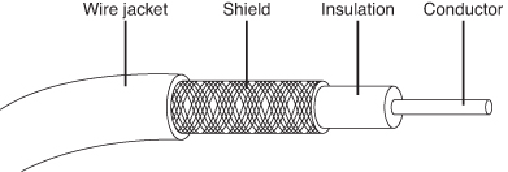Hardware Reference
In-Depth Information
The bus, star, and ring topologies are discussed in the following sections. Wireless net-
working, which technically doesn't have a physical topology as described here, does still
employ two logical (virtual) topologies, which I discuss as well.
Bus Topology
The earliest type of network topology was the
bus topology
, which uses a single cable to
connectallthecomputersinthenetworktoeachother,asshownin
Figure17.14
.Thisnet-
work topology was adopted initially because running a single cable past all the computers
in the network is easier and uses less wiring than other topologies. Because early bus to-
pologynetworksusedbulkycoaxialcables,thesefactorswereimportantadvantages.Both
10BASE-5(thick)and10BASE-2(thin)Ethernetnetworksarebasedonthebustopology.
Figure 17.14
A 10BASE-2 network is an example of a linear bus topology, attaching all network devices
to a common cable.
However,theadventofcheaperandmorecompactunshieldedtwisted-paircabling,which
also supports faster networks, has made the disadvantages of a bus topology apparent.
If one computer or cable connection malfunctions, it can cause all the stations beyond it
on the bus to lose their network connections. Thick Ethernet (10BASE-5) networks of-
ten failed because the vampire tap connecting the AUI device to the coaxial cable came
loose. In addition, the T-adapters and terminating resistors on a 10BASE-2 Thin Ethernet
network could come loose or be removed by the user, causing all or part of the network
to fail. Another drawback of Thin Ethernet (10BASE-2) networks was that adding a new


